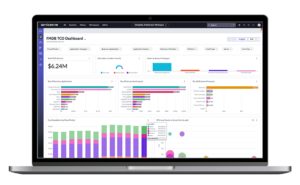ServiceNow is at the forefront of digital transformation, with a staggering 85% of Fortune 500 companies using the platform to manage IT operations.
But while ServiceNow is rich in operational data, harnessing its full potential for decision-making hinges on the availability of accurate IT spend data.
How can organizations bridge this gap? The answer is using IT financial management to complement the robust capabilities already available in ServiceNow.
Below we explore the compelling reasons why companies using ServiceNow should consider adding IT financial management to their suite of ServiceNow tools.
Discover more in our free eBook: 4 Steps to a Healthier IT Financial Management Practice Beyond Spreadsheets
Leveraging Your Existing Operational Data
If your organization uses ServiceNow, much of the operational data you need for cost modeling, budgeting and financial reporting is readily available there, including data on:
- Assets
- Resources
- Financials
- Utilization
While IT departments currently use this data for analysis and decision-making, they do so in the absence of detailed financial data.
An IT financial management tool solves this problem by pulling data from sources such as ERP, CRM and cloud applications, enriching the ServiceNow platform with deep financial insights. A flexible cost model is essential here, allowing companies to utilize a technology business management (TBM) or IT financial management framework (ITFM), or a combination of the two.
Fast, Seamless Data Processing
Running a monthly bill of IT can involve an overwhelming amount of data, often exceeding a million lines of data in a single month. Given that many organizations are under pressure to close financial records in the initial five days of the month, being able to process detailed data quickly and accurately is vital.
There is, of course, one caveat: when looking at options for an IT financial management solution that runs natively on ServiceNow, organizations must ensure it’s a solution capable of processing this volume of data at speed. This is what will allow you to get answers in minutes rather than days, without straining the entire ServiceNow system. An open data model also provides a critical advantage, so that companies can access their data on business intelligence platforms like Tableau or PowerBI with a simple integration.
CFO-Approved Financial Data
While ServiceNow provides visibility into IT operational data, on its own it doesn’t provide financial information at the level of detail and depth required by IT and finance leaders to better decision their technology spend.
By using an IT financial management application on ServiceNow, companies can drill down into detailed costs for services, applications, consumers and business capabilities. Integrating ServiceNow with financial systems ensures alignment between corporate finance and IT, fostering the trust and confidence required to garner support for IT initiatives.
Maximizing ServiceNow ROI
Bringing IT financial management into ServiceNow also enhances the value you get from other ServiceNow core services and applications, integrating seamlessly with your asset database, configuration management database (CMDB) and all other core ServiceNow areas. Financial data can be summarized and targeted to the needs of different groups, including:
- CIOs
- IT managers and controllers
- Portfolio and project managers
- Line of business (LOB) managers
- Department and resource managers
- Individuals
An example would be if you’re using ServiceNow application portfolio management (APM). Here an IT financial management application in ServiceNow can connect granular data on IT spend and utilization to individual applications to provide accurate calculations of total cost of ownership and unit cost. This means managers can make better rationalization decisions faster, without additional data from finance.
Reducing Application Sprawl
Implementing an IT financial management tool in ServiceNow helps reduce application sprawl, leveraging your team’s existing ServiceNow expertise and simplifying security and management.
For example, your company’s ServiceNow experts already know how to manage integrations there, build out reports and create custom dashboards for users. That means your team doesn’t need to learn a new tool to start generating powerful IT spend insights.
In a similar vein, bringing IT financial management into ServiceNow simplifies user security and administration. With user roles and data access rules already defined in ServiceNow, you eliminate the duplicate effort and cost of managing a standalone IT financial management product.
The outcome: lower total cost of ownership, fewer applications to manage and greater efficiency overall.
Embedding IT Financial Management in the Business
The ability to push financial data to ServiceNow promotes buy-in for IT financial management, embedding it into the business as people become reliant on the data to make decisions.
Integrating financial systems and data with ServiceNow creates a single source of truth that connects operational and IT finance data. Because this is where IT professionals work every day, IT financial management becomes inherently more valuable to the company.
A New Approach to IT Financial Management
To help companies maximize the value of their ServiceNow investment, Nicus recently launched its ITFM platform on Now, a native ServiceNow application offering enterprise-scale IT financial management capabilities that includes cost transparency and IT planning.
Nicus is the only IT financial management application on ServiceNow that can seamlessly process millions of lines of data necessary to support large enterprises. Its open and flexible data model enables the Nicus platform to support a huge amount of complexity and nuance to reflect whatever kind of allocations a customer wants. This also enables easy integration with business intelligence tools, delivering both the deep IT spend insights and robust data that business and finance leaders need.
Many users who need to know the financial impacts of what IT is doing are already looking at dashboards and data in ServiceNow. Adding Nicus IT financial management creates a synergistic effect that unites IT and finance around a common goal: getting the most from your technology investments.
Download a free presentation on Evaluating & Implementing ITFM Solutions






